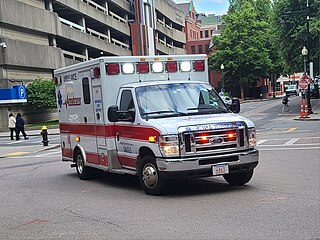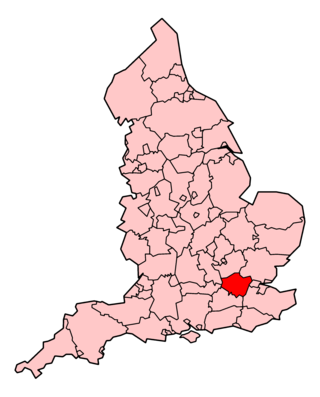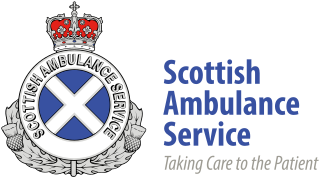
Emergency medical services (EMS), also known as ambulance services or paramedic services, are emergency services that provide urgent pre-hospital treatment and stabilisation for serious illness and injuries and transport to definitive care. They may also be known as a first aid squad, FAST squad, emergency squad, ambulance squad, ambulance corps, life squad or by other initialisms such as EMAS or EMARS.

An ambulance is a medically equipped vehicle used to transport patients to treatment facilities, such as hospitals. Typically, out-of-hospital medical care is provided to the patient during the transport. Ambulances are used to respond to medical emergencies by emergency medical services (EMS), and can rapidly transport paramedics and other first responders, carry equipment for administering emergency care, and transport patients to hospital or other definitive care. Most ambulances use a design based on vans or pickup trucks, though others take the form of motorcycles, buses, hearses, aircraft and boats.

Almaty, formerly Alma-Ata, is the largest city in Kazakhstan, with a population of over two million. It was the capital of Kazakhstan from 1929 to 1936, while the country was an autonomous republic of the Soviet Union, then from 1936 to 1991, a union republic and finally from 1991, an independent state. In 1997, the government relocated the capital to Akmola.

An emergency department (ED), also known as an accident and emergency department (A&E), emergency room (ER), emergency ward (EW) or casualty department, is a medical treatment facility specializing in emergency medicine, the acute care of patients who present without prior appointment; either by their own means or by that of an ambulance. The emergency department is usually found in a hospital or other primary care center.

The Queen's Medical Centre is a teaching hospital situated in Nottingham, England. Until February 2012, when it was surpassed by the Royal London Hospital, it was the largest hospital in the United Kingdom, though it remains the largest major trauma centre in England. It is managed by Nottingham University Hospitals NHS Trust.
The NewYork-Presbyterian Hospital, a nonprofit academic medical center in New York City, is the primary teaching hospital for two Ivy League medical schools, Weill Cornell Medicine at Cornell University and Columbia University Vagelos College of Physicians and Surgeons at Columbia University. The hospital includes seven campuses located throughout the New York metropolitan area. The hospital's two flagship medical centers, Columbia University Irving Medical Center and Weill Cornell Medical Center, are located on opposite sides of Upper Manhattan.

The London Ambulance Service NHS Trust (LAS) is an NHS trust responsible for operating ambulances and answering and responding to urgent and emergency medical situations within the London region of England. The service responds to 999 phone calls across the region, and 111 phone calls from certain parts, providing triage and advice to enable an appropriate level of response.

Netcare Limited is a South African private healthcare company. It operates through a number of subsidiaries and employs just over 21 000 people.

The Scottish Ambulance Service is part of NHS Scotland, which serves all of Scotland's population. The Scottish Ambulance Service is governed by a special health board and is funded directly by the Health and Social Care Directorates of the Scottish Government.

The West Midlands Ambulance Service University NHS Foundation Trust (WMAS UNHSFT) is responsible for providing NHS ambulance services within the West Midlands region of England. It is one of ten ambulance trusts providing England with emergency medical services, and is part of the National Health Service.
Rashid Hospital is a 786-bed government foundered district general hospital in Dubai, the United Arab Emirates, and is a part of the Dubai Health Authority. Built in 1973, it is the city's second oldest hospital, and is located on the Oud Metha Road adjacent to Dubai Creek.

Utah Valley Hospital (UVH) is a 395-bed full-service tertiary and acute care referral center serving Utah County, central and southern Utah that is part of the Intermountain Healthcare system. It is a Level II Trauma Center. From 1984 to 2016, the facility was called Utah Valley Regional Medical Center (UVRMC).

The former Mackinnon Memorial Hospital building is now vacant; it sits adjacent to the new Broadford Hospital, all services having moved into this new purpose built building in March 2022. It was a community hospital, located in the village of Broadford on the Isle of Skye. It was managed by NHS Highland.
Hamad Medical Corporation (HMC) is Qatar’s main not-for-profit health care provider, and is based in Doha. It was established by Emiri Decree No. 35 in 1979. HMC manages several hospitals, as well as emergency, specialized, and ambulatory care centers, and operates both the national ambulance service and a home healthcare service.

The Healthcare in Kazakhstan is a post-Soviet healthcare system under reform. The World Health Organization (WHO), in 2000, ranked the Kazakhstan's healthcare system as the 64th in overall performance, and 135th by overall level of health.
Blue Mountain Hospital offers medical services in John Day, Oregon, United States. Part of the Blue Mountain Hospital District, it was built in 1949 in Prairie City and re-built in 1960 in John Day. The hospital district, a non-profit managed by a local board of directors, includes Blue Mountain Nursing Home, a 52-bed unit in Prairie City.

Oslo University Hospital is a university hospital in Oslo, Norway. With over 24,000 employees it is the largest hospital organization in Europe. It is affiliated with the Faculty of Medicine of the University of Oslo and is one of the largest medical research institutions in Europe.
Calmette Hospital or L'hôpital Calmette, located on Monivong Boulevard in Phnom Penh, is a public hospital managed by Ministry of Health and funded by the Cambodian and French governments. It is considered as Cambodia's flagship health care centre. The hospital was named after Albert Calmette, a renowned French bacteriologist.
The COVID-19 pandemic in Kazakhstan was a part of the worldwide pandemic of coronavirus disease 2019 caused by severe acute respiratory syndrome coronavirus 2. The virus was confirmed to have reached Kazakhstan on 13 March 2020 after two Kazakh citizens in Almaty returned from Germany. That same day, two more cases were confirmed, with one female arriving from Italy in Astana and the other from Germany in Almaty as well. Following the outbreak, on 15 March 2020, President Kassym-Jomart Tokayev declared a state of emergency that was set to last until 15 April 2020. However, measures were prolonged in order to curb the transmission of the virus, leading to many notable holidays such as Nowruz and the Victory Day being cancelled. On 19 March 2020, a strict quarantine was placed on the cities of Astana and Almaty, where the most cases were occurring. On 30 March 2020, Atyrau and five cities in Karaganda Region went under a lockdown.
The impact of the COVID-19 pandemic on hospitals became severe for some hospital systems of the United States in the spring of 2020, a few months after the COVID-19 pandemic began. Some had started to run out of beds, along with having shortages of nurses and doctors. By November 2020, with 13 million cases so far, hospitals throughout the country had been overwhelmed with record numbers of COVID-19 patients. Nursing students had to fill in on an emergency basis, and field hospitals were set up to handle the overflow.













